October 9, 2020
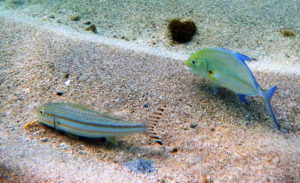
A bandtail goatfish, called weke pueo, digs for shrimp and crabs, with a jack following, hoping for leftovers ©Susan Scott
Hawaii’s goatfish are bottom feeders that often forage in places easy for us snorkelers to enter the water, that is, in white sand only a few feet deep. That’s why, after about five minutes of snorkeling with visiting friends and family, I’m ready for this predictable question: “What are those fish?”
I’m also ready for the next question: “Did you say goat?”

Goatfish got their name from goat beards. (Myrtle proving it’s ok for a lady to have a little facial hair, bit.ly/3jOhugo, Reddit)
Yes. Goat. Apparently, the two muscular organs that the fish extend from beneath their mouths to stir up creatures in the sand reminded someone of a goat’s beard. Unlike a goat, however, the fish, when not feeding, can hide its so-called beard. The two taste and smell organs, called barbels, fit neatly into grooves under the fish’s chin.
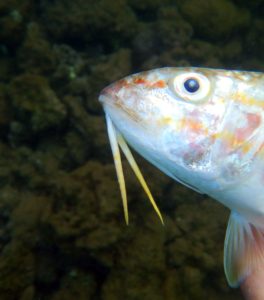
A goatfish’s two sensory and digging organs tuck up into grooves under the chin when not in use. ©Susan Scott

This extraordinary photo taken by my friend Russell Gilbert shows two manybar goatfish (moano) using their barbels to either fight or to befriend, we don’t know which. ©Russell Gilbert.
Hawaii hosts 10 goatfish species. Eight are found throughout the Pacific and Indian Oceans but two live only in Hawaii. Most of us will never see one, the yellowbarbel goatfish, because it’s a deep-water species of the Northwestern Hawaiian Islands.
The other endemic, however, is the whitesaddle goatfish, or kūmū, found in the main Hawaiian islands. Individual kumu can be gray, green or red, but all have a white spot, or “saddle,” near the tail.
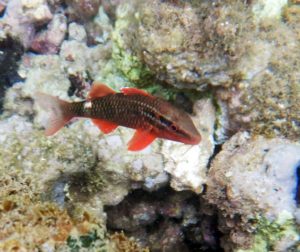
A juvenile kūmū. ©Susan Scott
Kūmū were once common in Hawaii’s shallow waters, but since the 1980s this popular food fish has declined in numbers. Some local anglers believe that the decline of kūmū is due to the introduced (from the Marquesas in 1958) bluestripe snapper (AKA ta’ape) eating baby kūmū and competing with adults for food. UH researchers, however, studying diet and habitat of Hawaii’s native goatfish and the nonnative ta’ape found no such connection bit.ly/3jHzSI1.
The kūmū decline is likely from overfishing, not a popular explanation.
But because kūmū rest in nooks and crannies during the day, and usually come out only at night to feed, this isn’t the kind of goatfish that my visitors spot first. Rather, it’s the square-spot goatfish, a species with enough names, and explanations of those names, to fill the rest of this article.
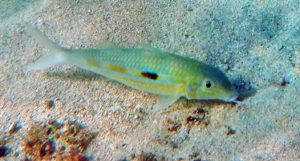
A squarespot goatfish. ©Susan Scott
I won’t do that, but when talking about these common fish, it’s handy to know that besides square-spot goatfish, another English name is yellowstripe goatfish. Hawaiians named it weke’ā. You will also hear the Hawaiian name ‘oama for goatfish of this and other species when the fish are under 7-inches long.
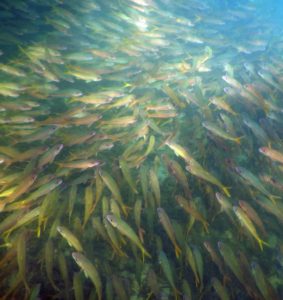
Baby yellowfin goatfish, called ‘oama when this small. ©Susan Scott
The name square-spot comes from the small black square that appears on the fish’s sides when its feeding, and the name yellowstripe from the yellow line that runs the length of the fish, also when feeding. Both these markings, however, fade or even disappear, when the fish is resting. Goatfish species can change their stripes, bars and colors in the blink of an eye, sometimes making ID of individual goatfish species hard.
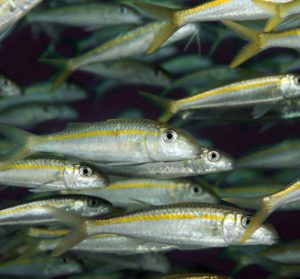
A school of squarespot goatfish minus their square spots. Another outstanding photo courtesy of ©Russell Gilbert
But recognizing family members is easy. If, while snorkeling, you see a fish of any color, with a goatee, digging up the ocean floor, sometimes in only two feet of water, with jacks or other species tagging along for leftovers, it’s a Mulloidichthys or a Parupeneus surmullet of the family Mullidae. Or just call it a goatfish.
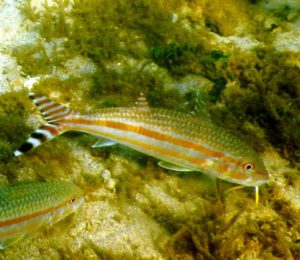
Bandtail goatfish, also known as weke pueo after the bars on the feathers of Hawaii’s native owl, the pueo. ©Susan Scott